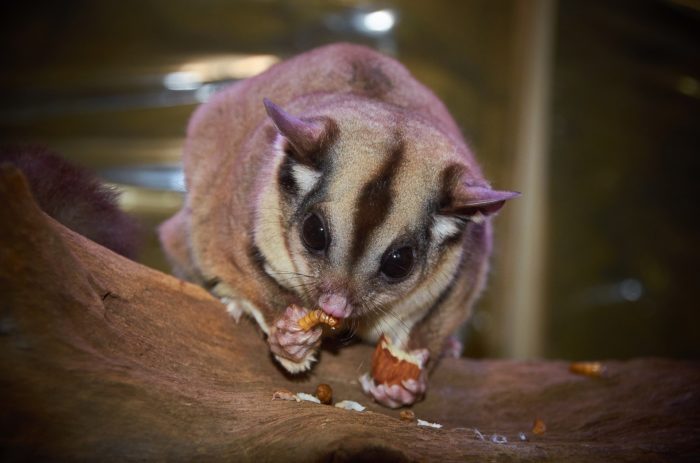
So, you’ve finally decided it’s time to add a furry little companion to your household—and with so many adorable pets to choose from, finding the perfect addition to your family can be difficult. In order to have a “unique” pet, many are seeking out exotic animals, such as parrots and monkeys. Sugar gliders are another popular choice because of their small size and their ability to glide through the air. Unfortunately, keeping sugar gliders as pets has many drawbacks—not only does it support the exotic pet trade, it also disrupts a sugar glider’s natural way of living.
Sugar gliders are small marsupials that are native to Australia, New Guinea, and Indonesia. These tree-dwelling possums were first introduced into the United States in the mid-1990s and since then, the sugar glider pet industry has boomed. Overall, the exotic pet trade encompasses the importation and exportation of wild animals—an industry that is worth $15 billion dollars in the United States alone.
Since many are unaware of the high level of responsibility caring for a wild animal entails, many exotic animals purchased from the pet trade end up being abandoned or highly neglected. For this reason, it is important to not support the cruel exotic pet trade and to choose a pet that you will be able to care for in the long run. Although they are cute and may seem easy to handle, here are 6 reasons why you shouldn’t have a sugar glider as a pet.
1. Affects Populations in the Wild
Sadly, animals caught in the exotic pet trade are often ripped from their families. Since infants are generally preferred, the mothers are often killed in order for her young to be taken. Because sugar gliders are incredibly family oriented, they are easy to catch in the wild as they congregate in large groups. Although sugar gliders are considered of “least concern” on the IUCN’s Red List of Threatened Species, they are one of the most heavily exploited animals—especially in Indonesia.
2. Encourages Breeding in Mills
So, you’ve heard about puppy mills—but what about sugar glider mills? In addition to obtaining sugar gliders from the wild, many are often bred in mills in order to meet high demands. Similar to puppy mills, sugar gliders bred in mills live in deplorable conditions and are often neglected, abused, and confined to small cages. Purchasing a sugar glider supports these mills and helps to increase the overall profit of the exotic pet trade.
3. Incompatible Sleep Patterns
If you are seriously considering getting a sugar glider as a pet, you can say goodbye to a good night’s rest! Sugar gliders are nocturnal animals—sleeping throughout the vast majority of the daylight hours and remaining active throughout the night. The sleeping patterns of humans and sugar gliders are completely conflicting, making having a sugar glider as a pet an unrealistic option.
4. Specific Dietary Needs
Forget the ease of shopping for pet food at your local pet store! Unlike dogs and cats, a sugar glider’s diet is far more diverse. Being that they are natural omnivores, sugar gliders eat a diet that consists of plant products (nectar, pollen, and sap) as well as insects. The vast majority of people who keep sugar gliders as pets do not feed them a diet that is consistent with their needs. Many sugar gliders held in captivity face health problems due to an improper diet and may suffer from malnutrition, obesity, or dehydration.
5. Increased Chance of Death
A sugar glider’s average life expectancy is between 12 and 15 years, but these adorable little creatures are dying much sooner—living only six to eight years in captivity. Owning a sugar glider presents many health risks and they can suffer from a wide variety of other health issues such as anemia, diarrhea, and Leptospirosis (a disease that can be transmitted to humans). Sugar gliders must also live in warmer climates and flourish in temperatures ranging between 72°F and 76°F. Subjecting a sugar glider to cooler temperatures can put them at risk of pneumonia and other respiratory infections.
6. High Risk of Injury
Are you prepared for a costly vet bill? Keeping a sugar glider as a pet is not realistic as they need large amounts of space to move around in—and with very little space to jump and glide around, sugar gliders are likely to be injured and are prone to fractures. Sugar gliders also suffer from a host of mental health issues. Since sugar gliders are used to living in large groups, and they desire lots of attention. If left alone, stress, depression, and other behavioral problems can persist leading to self-mutilation in the form of over-licking and skin chewing.
Wild animals are best adored…in the wild. Safaris and even volunteering at sanctuaries are great ways to observe them. Have you tried these activities?
__
Also by Audrey: 3 Keystone Species We Can’t Live Without—Here’s How You Can Help Save Them
Related: What the Dog Meat Trade Taught Me About Compassion
3 Furry Friends You Should Consider Adopting
Get more like this—Subscribe to our daily inspirational newsletter for exclusive content!
__
Photo: Pixabay
